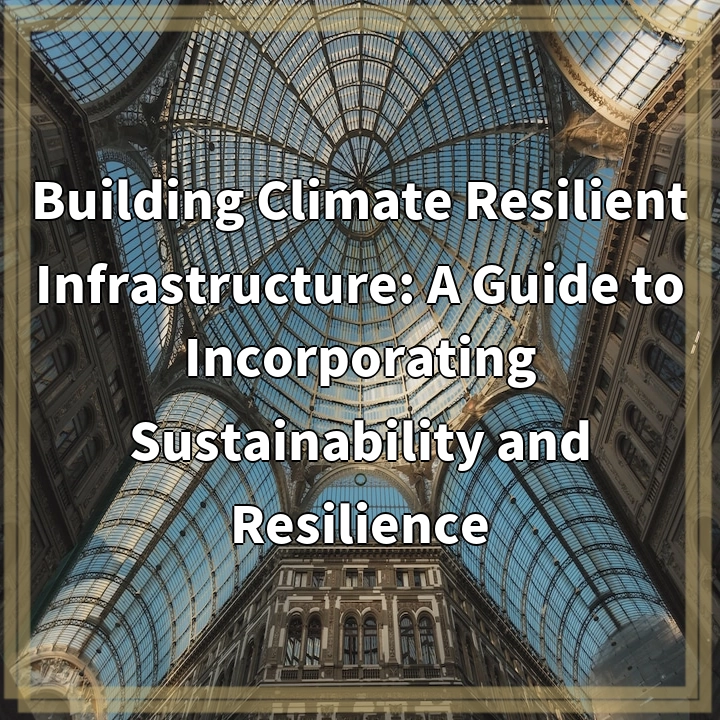
What is Building Climate Resilient Infrastructure?
Building climate resilient infrastructure refers to the process of designing, constructing, and maintaining infrastructure systems that are able to withstand the impacts of climate change. This involves incorporating sustainability and resilience principles into the planning and implementation of infrastructure projects.
Climate resilient infrastructure aims to minimize vulnerabilities and increase the capacity of infrastructure systems to adapt to changing climate conditions. It takes into account the projected risks such as sea level rise, increased frequency and intensity of extreme weather events, and changes in precipitation patterns.
Real-World Problems Associated with Building Climate Resilient Infrastructure
While building climate resilient infrastructure is essential for the long-term sustainability and functioning of society, there are several real-world problems that need to be addressed:
1. Funding and Financial Constraints
One of the main challenges faced in building climate resilient infrastructure is securing adequate funding. The costs associated with incorporating climate resilience measures into infrastructure projects can be substantial. Convincing governments, investors, and stakeholders to allocate sufficient funds for these initiatives is often difficult.
2. Lack of Awareness and Understanding
There is a lack of awareness and understanding among policymakers, engineers, and the general public regarding the importance of building climate resilient infrastructure. Many still prioritize traditional approaches without fully considering the climate risks and vulnerabilities. This highlights the need for education and awareness campaigns to bridge this knowledge gap.
3. Technical and Engineering Challenges
Implementing climate resilience measures involves complex engineering and technical considerations. This includes incorporating climate data and projections into design plans, utilizing innovative materials and construction techniques, and designing flexibility into infrastructure to accommodate uncertainties in future climate conditions.
4. Integration with Existing Infrastructure
Many infrastructure systems are already in place and were not designed with climate change in mind. Retrofitting or integrating climate resilience into existing infrastructure can be challenging due to space constraints, compatibility issues, and cost considerations. Striking a balance between retrofitting existing systems and building new climate resilient infrastructure is a key challenge.
5. Social and Equity Considerations
Building climate resilient infrastructure should not only focus on technical aspects but also consider social equity and inclusivity. Vulnerable communities are often disproportionately affected by the impacts of climate change and may have limited capacity to adapt. Ensuring that climate resilient infrastructure benefits all communities and does not exacerbate existing inequalities is crucial.

Solutions for Building Climate Resilient Infrastructure
Addressing the challenges associated with building climate resilient infrastructure requires a multifaceted approach. Here are some potential solutions:
1. Increasing Financial Support
Governments, international organizations, and private investors should allocate adequate funding for climate resilient infrastructure projects. This can be done through innovative financing mechanisms, public-private partnerships, and leveraging climate finance sources.
2. Raising Awareness and Education
Efforts should be made to raise awareness and educate stakeholders about the importance of building climate resilient infrastructure. This includes training programs for engineers, planners, and policymakers, as well as public awareness campaigns to engage and inform the general public.
3. Enhancing Technical Expertise
Improving technical expertise is crucial for successful implementation of climate resilience measures. Engineers and architects should receive training on integrating climate data, utilizing innovative design techniques, and incorporating flexibility into infrastructure systems. Collaboration and knowledge-sharing platforms can also facilitate the exchange of best practices.
4. Prioritizing Integration and Retrofitting
Efforts should be made to prioritize the integration of climate resilience measures into existing infrastructure systems. This includes conducting vulnerability assessments, identifying critical areas for retrofitting, and utilizing innovative solutions such as green infrastructure and nature-based approaches to enhance resilience.
5. Promoting Equity and Social Inclusion
Building climate resilient infrastructure should be done with a focus on social equity and inclusion. This involves engaging local communities in the planning and decision-making processes, ensuring equitable access to benefits, and addressing the specific needs and vulnerabilities of marginalized groups.















